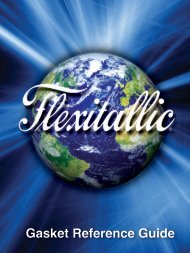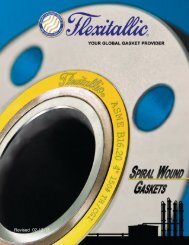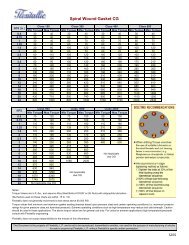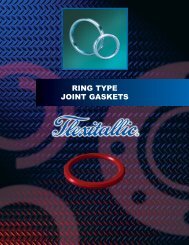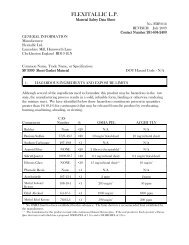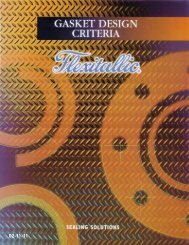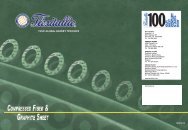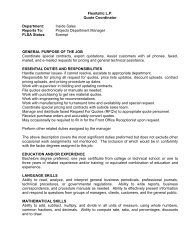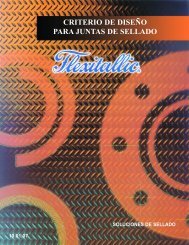SF1600 - The Flexitallic Group
SF1600 - The Flexitallic Group
SF1600 - The Flexitallic Group
You also want an ePaper? Increase the reach of your titles
YUMPU automatically turns print PDFs into web optimized ePapers that Google loves.
GENERAL INFORMATION<br />
Manufacturer:<br />
<strong>Flexitallic</strong> Limited<br />
Lancashire Mill, Hunsworth Lane<br />
Cleckheaton England BD19 4LN<br />
FLEXITALLIC L.P.<br />
Material Safety Data Sheet<br />
No. FDP-013<br />
REVISED: July 2009<br />
Contact Number 281-604-2400<br />
Common Name, Trade Name, or Specification:<br />
SF 1600 - Sheet Gasket Material DOT Hazard Code - N/A<br />
1. HAZARDOUS INGREDIENTS AND EXPOSURE LIMITS<br />
Although several of the ingredients used to formulate this product may be hazardous in the raw<br />
state, the manufacturing process results in a solid, infusible form, binding or otherwise rendering<br />
the mixture inert. We have identified below those hazardous constituents present in quantities<br />
greater than 1% (0.1% for carcinogens) that may be released from the product by overheating,<br />
burning, machining, abrading, or riveting.<br />
CAS<br />
Component Number % OSHA PEL ACGIH TLV<br />
Rubber<br />
Barium Sulfate<br />
Calcium Carbonate<br />
Iron Oxide Dust<br />
Fibrous Glass<br />
None<br />
7727-43-7<br />
1317-65-3<br />
130-37-1<br />
NONE<br />
Auto-ignition Temperature: This product is inherently flame resistent.<br />
Flammable Limits in Air: % in Air by Volume: LEL: N/A UEL: N/A<br />
Extinguisher Media: Carbon dioxide, chemical, or foam<br />
Special Firefighting Procedure: Material in or near fires should be cooled with a water<br />
spray or fog. A self-contained breathing apparatus, operating in the positive pressure<br />
mode, and full fire fighting protective clothing should be worn for combative fires.<br />
Unusual Fire and Explosion Hazards: <strong>The</strong>rmal decomposition or combustion may<br />
produce dense smoke, oxides of carbon, and low molecular weight organic compounds<br />
whose composition has not been characterized.<br />
4. PHYSICAL HAZARDS AND REACTIVITY DATA<br />
Stability: Stable at normal temperatures and storage conditions<br />
Incompatibility: None<br />
Hazardous Decomposition Products: None<br />
Hazardous Polymerization: Will not polymerize. This product is fully cured in the<br />
manufacturing process.<br />
5. HEALTH HAZARDS<br />
Carcinogenicity:<br />
Rubber<br />
Barium Sulfate<br />
Calcium Carbonate<br />
Iron Oxide<br />
Fibrous Glass<br />
NTP Listed<br />
No<br />
No<br />
Yes<br />
No<br />
No**<br />
IARC Listed<br />
No<br />
No<br />
Yes**<br />
No<br />
No**<br />
NIOSH Listed<br />
No<br />
No<br />
Yes<br />
No<br />
OSHA Listed<br />
* IARC classifies “continuous filament glass dust” as "not classifiable with respect to human carcinogenicity." (<strong>Group</strong> 3)<br />
IARC and NTP classify “fibrous glass dust” as “possible carcinogenic to humans.” (<strong>Group</strong> 2B)<br />
Symptoms and Effects of Exposure to the Individual Components:<br />
RUBBER (POWDERED)<br />
Inhalation hazards - May cause mild irritation of respiratory tract. Repeated and prolonged inhalation of<br />
dust may lead to a benign pneumoconiosis. This condition may cause some lung function impairment but<br />
is reversible with reduced exposure.<br />
Other hazards - Eyes - may cause mild transient eye irritation.<br />
BARIUM SULFATE<br />
No<br />
No<br />
No<br />
No<br />
No<br />
No
Inhalation hazards - Should be treated as a nuisance dust. Exposure to Barium Sulfate may cause<br />
paroxsymal coughing, wheezing, difficult breathing and upper respiratory tract irritation.<br />
Other hazards - No adverse effects have been reported from ingestion. Eye contact may cause temporary<br />
discomfort and irritation.<br />
CALCIUM CARBONATE<br />
This substance is a severe eye irritant and moderate skin irritant. Calcium carbonate is a common air<br />
contaminant<br />
IRON OXIDE DUST<br />
Inhalation hazards - Repeated or prolonged exposures to iron oxide dust may cause a form of benign<br />
pneumoconiosis called siderosis. Exposure is generally not associated with pulmonary fibrosis or disability<br />
unless there is concurrent exposure to other fibrosis-producing materials such as silica.<br />
Other hazards - Contact may cause skin and eye irritation.<br />
FIBROUS GLASS<br />
Inhalation hazard - Acute: mechanical irritation of mouth, nose, throat. Itching and irritation of upper<br />
respiratory tract.<br />
Other hazards - transient mechanical irritation to skin. Direct contact with eyes will cause mechanical<br />
irritation. May cause unpleasant deposits in eyes, ears and nasal passages. IARC categorizes “continuous<br />
filament glass dust” as not classifiable relative to human carcinogenicity (<strong>Group</strong> 3). However, if the end<br />
product is finely ground, a fibrous glass dust may result, which IARC classifies as “possibly carcinogenic to<br />
humans” (<strong>Group</strong> 2B).<br />
6. FIRST AID<br />
Inhalation: Move to fresh air. Obtain medical attention.<br />
Eyes: Flush with water to remove particulate. Obtain medical attention.<br />
Skin: Wash thoroughly with soap and water. If persistent irritation develops, obtain<br />
medical attention.<br />
Ingestion: Obtain medical attention.<br />
7. SPECIAL PRECAUTIONS AND SPILL / LEAK PROCEDURES<br />
Handling and Storage : Shipping and storage may result in accumulation of dust in<br />
shipping containers. If this occurs, dispose of the container in an airtight<br />
polyethylene bag (see disposal instructions below) or remove dust by vacuuming or<br />
wet mopping. Vacuums used for this purpose should be equipped with HEPA<br />
filters. Do not use compressed air to blow dust from storage containers.<br />
Release or Spill : If a release of dust occurs during machining, abrading, or riveting,<br />
remove dust by vacuuming or wet mopping. Vacuums used for this purpose<br />
should be equipped with HEPA filters. Do not use compressed air to blow dust<br />
from the workplace.<br />
Waste Disposal : Disposal of solid waste is regulated by federal and state law. Waste<br />
should be placed in airtight containers, and disposed of properly. Contact local<br />
regulatory agency for guidance.
8. PERSONAL PROTECTION AND CONTROL<br />
Respiratory Protection : Use NIOSH-approved respirator if exposure to dust, vapors, or<br />
fumes in concentrations exceeding PEL's or TLV's is possible. (See 29 CFR<br />
1910.134 for respiratory protection standards)<br />
Ventilation : Any operations which may produce dust, including machining, grinding,<br />
riveting, or abrading of this product, should be adequately exhausted to prevent<br />
inhalation of dust.<br />
Personal Protective Equipment : Suitable respiratory protection should be worn if dust<br />
exposure is possible. All regulations and safe practices related to the use of respiratory<br />
protection must be observed. Refer to OSHA standards and NIOSH guidelines. If skin<br />
irritation occurs, gloves and other protective garments may be worn.<br />
<strong>The</strong> information and recommendations set forth herein are taken from sources believed to be<br />
accurate as of the date of revision. <strong>Flexitallic</strong>, Inc. makes no warranty with respect to the<br />
accuracy of the information or the suitability of the recommendations, and assumes no liability,<br />
including direct, incidental or consequential damages for any reliance thereon.<br />
This MSDS should not be used as a complete or accurate summary of the content of the<br />
product. For specific information on brand names, manufacturer’s, or quantities, please<br />
refer to specific product specification documents where available.



